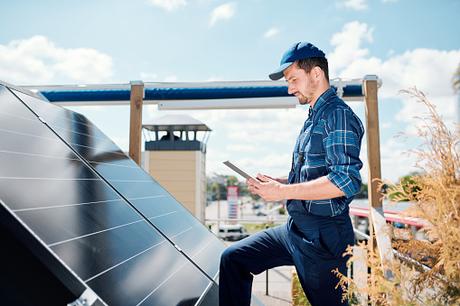Solar panel repair can be a daunting task for anyone, let alone someone who is not familiar with the mechanics of solar panels. In this guide, we will cover the different types of tools you will need for solar panel repair, and walk you through the steps of using each one. By following this guide, you will be able to tackle any solar panel repair project with ease!

What is a solar panel and where does it come from?
Solar panels are a device that converts sunlight into electrical energy. Solar panels come in a variety of shapes and sizes, but they all contain one or more solar cells. These cells collect energy from the sun and turn it into electricity.
Solar panels are made from different types of materials, including silicon, copper, and aluminum. The type of material used affects the panel's durability, cost, and performance.
The most common type of solar panel is the monocrystalline cell. Monocrystalline cells are made from a single layer of silicon crystals. They're the most affordable type of panel and they have good performance overall. However, monocrystalline cells aren't as durable as other types of panels and they're not as efficient at converting sunlight into electricity.
The second most common type of solar panel is the polycrystalline cell. Polycrystalline cells are made from multiple layers of silicon crystals. They have better durability than monocrystalline cells and they generate more electricity than monocrystalline cells do. However, they're more expensive than monocrystalline cells and their performance isn't as good as that of polycrystalline
Types of solar panels
There are many different types of solar panels on the market, but most fall into one of two categories: monocrystalline or polycrystalline. Monocrystalline panels are made from a single crystalline silicon wafer, while polycrystalline panels are made from many smaller crystalline silicon wafers.
The main difference between monocrystalline and polycrystalline solar panels is how they generate energy. Monocrystalline solar panels use light to convert the sun's energy into electricity, while polycrystalline solar panels use electricity to drive a motor that turns a shaft that moves the light through the panel to create an image.
If you're looking to buy a new solar panel, there are a few things you need to know. The first is the wattage rating of the panel - this tells you how much power the panel will generate. The second is the type of panel - monocrystalline or polycrystalline. The third is the warranty - some manufacturers offer longer warranties than others. And finally, you'll need to decide whether you want an integrated system or an off-the-shelf system.
Integrated systems are usually more expensive than off-the-shelf systems, but they offer a higher level of flexibility and convenience. Off-the-shelf systems are cheaper, but they may not have all the features you need.
How to fix solar panels
Solar panels are an important part of your home's energy supply, and as such, they can become damaged over time. If your solar panel is not working properly, you may need to repair it. This guide will teach you how to fix solar panels using the right tools and techniques.
Before you start repairing your solar panel, it is important to inspect it for any damage. Look for cracks in the plastic frame, corrosion on the metal parts, and missing or broken pieces. If you find any of these problems, you will need to address them before you can continue.
If the solar panel is cracked or corroded, it may be best to remove the damaged parts before you repair them. You can do this by using a screwdriver or a drill to remove the screws that hold the solar panel in place. Once the screws are removed, gently pull the solar panel off of the mounting frame.
Once the solar panel has been removed, you can replace the damaged parts with new ones. You will need to purchase a new mounting frame, solar panels (if necessary), and screws. Make sure to select an appropriate replacement part for your specific solar panel model. Once you have replaced the damaged parts, reattach the solar panel to the mounting frame using the screws that were originally provided.
What to Look for in Solar Panel Repair?
When it comes to repairing solar panels, it's important to know the different types of tools that are available. When looking for a solar panel repair tool, there are some things you should consider.
The most common type of solar panel is the crystalline silicon panel, which accounts for over 95% of all panels installed. These panels use standard hardware and require no special tools. However, there are other types of panels out there that require different repair tools. For example, polycrystalline silicon (PCS) panels use different kinds of hardware and need specialized tools in order to fix them.
Here is a list of the most common solar panel repair tools and what they are used for:
- Drill bit: Used to enlarge or remove holes in solar cells
- Hammer: Used to smash cells in order to remove paint or insulation
- Tape measure: Used to measure distances and angles
- Needle-nose pliers: Used to grip and remove screws and bolts
- Wire cutters: Used to cut wire
How to Fix Common Problems with Solar Panels
If you're like most homeowners, your solar panel is probably working great most of the time. But there's a good chance that it's not working as well as it should be on occasion. Here are some common solar panel problems and how to fix them.
- A broken or loose wire: This is probably the most common problem with solar panels, and it can be easily fixed. Simply unplug the solar panel, locate the broken or loose wire, and replace it with a new one. Be sure to mark the position of the old wire so you can re-install it in the same spot once the replacement is done.
- A dirty or scratched solar panel: If your solar panel is dirty, you may not be getting as much sunlight as you should be. Clean your solar panel using a garden hose with a strong stream of water (or use a commercial cleaning solution). Be sure to rinse off all of the soap afterward, your panel will be ready for use again!
- A low battery: If your solar panel has been getting little to no sunlight for a while, it may be because of a low battery. To check your battery status, unplug your solar panel from the wall and check the power indicator on the panel. If the battery is low, you'll need to replace it.
- If your solar panel is not working at all, chances are that there's a broken or missing cable connecting it to the power source. To determine which cable is broken, remove all of the cables from the panel and visually inspect them for damage. If you can't A broken or missing cable: find any damage, then you may need to replace all of the cables on your solar panel.
Conclusion
A broken solar panel can be a major inconvenience, not to mention expensive. Fortunately, it is fairly easy to fix a solar panel if you have the right tools on hand. In this article, we will discuss the different tools needed for repairing solar panels and give you an idea of what to look for when purchasing them. Hopefully, this will help you get your solar panel fixed quickly and without any hassle!
